More Fleets Are Going Green at Their Facilities
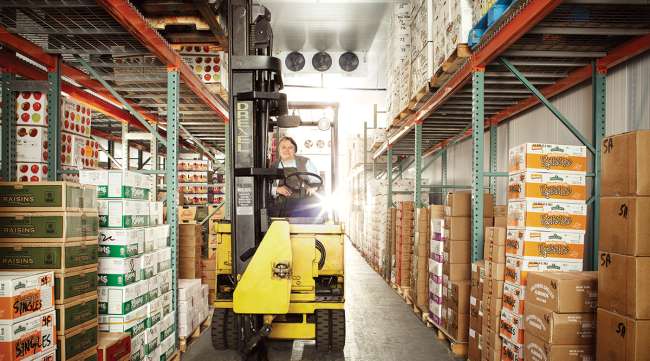
[Stay on top of transportation news: Get TTNews in your inbox.]
A growing number of transportation and logistics providers are cutting costs and going green with energy-efficient truck terminals and warehouses.
Installing more efficient lighting and climate control systems and moving to reusable packaging materials are among the ways that fleets are reducing energy consumption and waste at their facilities.
These eco-friendly practices benefit the bottom line and also bring soft benefits, such as improving public and employee relations.
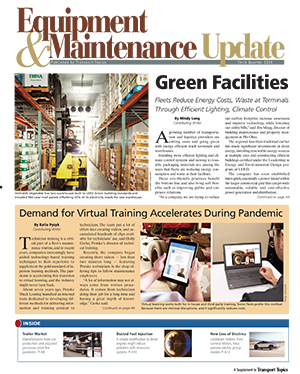
“As a company, we are trying to reduce our carbon footprint, increase awareness and improve technology, while lowering our utility bills,” said Jim Maug, director of building maintenance and property management at Pitt Ohio.
The regional less-than-truckload carrier has made significant investments in clean energy, installing renewable energy sources at multiple sites and constructing efficient buildings certified under the Leadership in Energy and Environmental Design program, or LEED.
The company has even established microgrids, essentially a power island within the larger commercial grid that can provide sustainable, reliable and cost-effective power generation and distribution.
Microgrids offer advantages over conventional utility-supplying methods in several areas, including resiliency, reliability, security, sustainability and economics, said Greg Reed, director of the University of Pittsburgh’s Center for Energy and the Energy GRID Institute.
Reed worked with Pitt Ohio on microgrids at the fleet’s new terminal in Parma, Ohio, and at its facility in Cheswick, Pa.
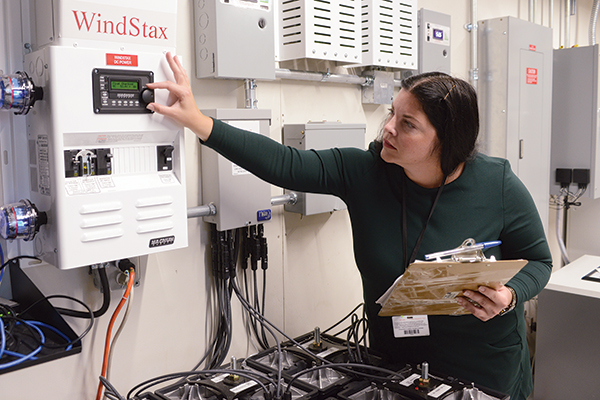
Pitt Ohio has made significant investments in clean energy, constructing LEED-certified buildings and installing renewable energy sources at multiple sites. (Pitt Ohio)
“They have sub-generation storage that serves more loads in the office end of a warehouse, especially during the daytime,” Reed said, adding that the systems use a combination of solar and wind energy along with battery storage.
Pitt Ohio also has embraced the use of direct current, or DC, connection technology. This approach can help reduce energy losses caused by converting energy to alternating current.

Reed
“In our lab, we’ve been working to eliminate some of that conversion and utilize more directly the energy we’re getting,” he explained.
Maug said using DC power to the fixture level is the most efficient use of renewable energy, and net metering the excess helps offset the company’s overall electric bill.
“We generate as much renewable energy as possible, store it on site, consume it directly and send the excess back to the utility,” he said.
Pitt Ohio, which is based in Pittsburgh and ranks No. 45 on the Transport Topics Top 100 list of the largest for-hire carriers in North America, has learned to balance the loads better through careful monitoring.
“Battery and system equipment technology has rapidly improved over time, giving us more ways to integrate renewable energy into our facilities,” Maug said, adding that to date, Pitt Ohio has saved more than $650,000 on energy costs.
Pitt Ohio also has reduced the amount of energy it needs to operate its facilities.

Deane
Graham Deane, chief operating officer of energy services firm UrbanVolt, said companies looking to go green should start by reducing energy demand.
“You want to do the efficiency first because you’ll need to produce less,” he said, noting that it costs about 10 times more to produce energy than to save it.
Veritable Vegetable, a provider of organic produce based in San Francisco, has two warehouses that were built to LEED standards.
“In 2008, we installed 560 solar roof panels, which offsets 33% of our electricity needs for one warehouse,” said Nicole Mason, the company’s director of community engagement.
Veritable Vegetable also signed up for San Francisco’s renewable energy program, CleanPowerSF, so all of its power comes from 100% renewable sources.
Installing Efficient Lighting
LED lighting is one way to cut down on energy demands.
Deane said there is enough of a difference between the energy consumed by traditional lighting systems and LED lighting to cover the cost of converting from the conventional to the new.
“A warehouse might have several hundred lights that draw 400 watts per hour. Those are replaced with LEDs to replace 80 to 100 watts per hour. You have a 75% reduction in light-by-light watt use,” he said.
UrbanVolt, which has an affinity program with American Trucking Associations, will replace, at no upfront cost, a facility’s older lighting systems with LED systems. UrbanVolt would then own the lighting systems and be responsible for maintenance and operation. After the lighting is installed, solar panels and batteries could be put on the facility’s roof or the ground nearby, providing power to run other sections of the warehouse, making the facility more energy self-sufficient.
“It is taking it off of your balance sheet and putting it onto your [profit and loss statement] as an operating expense,” Deane said.
A 250,000-square-foot warehouse can save $200,000 a year, he said. “After they pay for our service, there is still cash that is retained and goes straight to the bottom line.”

UrbanVolt will replace a facility’s older lighting systems with LED systems at no upfront cost. (UrbanVolt via Facebook)
Bruce Burges, facility manager for European logistics at Dachser Ireland Ltd., worked with UrbanVolt to replace lights at four of its terminal and warehouse facilities.
“With UrbanVolt’s model, they could buy the fittings on the lights and install them cheaper than we could do ourselves,” Burges said. “With UrbanVolt, you have a monthly fee with no upfront capital costs. It is easy to see when your electricity bill comes in what you’re paying, what your fee is to UrbanVolt, and the savings.”
Dachser’s savings have varied from one facility to another, but all have covered the cost of the new lights plus additional savings. One even achieved a 75% improvement in costs, Burges said.
A standard terminal or cross-dock warehouse that is open eight hours a day probably saves enough money to cover the cost, Deane said. “If it is open 12 hours a day, it has covered its cost, and there is a little bit of excess. As you get to 24 hours a day, you would save as much as it costs,” he said.
UrbanVolt determines potential savings by reviewing the size of the building, the hours of operation and the price of energy, which can vary widely depending on the region.
“In California, it can be 17 cents per kilowatt hour. Tennessee is probably spending 6,” Deane said.
Cargo Transporters worked with a local electrician and its local utility provider, Duke Energy, to install LED lighting starting in 2015. The Claremont, N.C.-based carrier has changed out lights at four of its buildings, Executive Vice President Jerry Sigmon Jr. said.
Cargo Transporters received a rebate from Duke Energy.
“This was a way to go green and be efficient at the same time and almost get paid for doing it,” Sigmon said.
What’s more, the lights came with a five-year warranty, which meant Cargo Transporters wouldn’t have to replace bulbs during that time and would have less maintenance.
Deane said there are no serviceable parts in an LED light.
“If there is a product failure, you replace it,” he said, adding that LED lights can last five to 10 years. UrbanVolt maintains and replaces lights as part of its service. “As long as the client keeps paying the service fee, we’ll replace the entire installation after five to seven years or whatever is appropriate,” Deane said.
This was a way to go green and be efficient at the same time and almost get paid for doing it.
Jerry Sigmon Jr., executive VP of Cargo Transporters, on installing LED lighting
LED light installation is relatively seamless, fleets said. Cargo Transporters’ contractor made the changes during regular business hours.
“If it were a larger room, we would take the power off of just one circuit at a time. It took about 10 to 15 minutes to change out one individual light,” Sigmon said, adding that it was completed over a few months.
Burges said Dachser added to its efficiency by utilizing sensors on the lights so they can turn on or off based on activity. The company also adjusted its minimum required light level depending on the area and utilized dial-up calculations to identify the needed lighting levels. Those calculations are essential because LED is a whiter light and can give the perception that the light level is higher.
“If you don’t get the dial-up calculation done, somebody will tell you that light is sufficient, and you’ll think it is great, but in a week or two, you’ll see people are making mistakes because you can’t read labels properly,” he said.
XPO Logistics has deployed LED lighting systems across its locations in Europe. It expects to have the systems installed in about 75% of its total space in that continent by the end of 2020. It uses sensors to adjust to natural light and activity levels, automatically detecting the optimal lighting for employees. The company estimates that its LED initiative, when fully implemented, has the potential to save 2,200 tons of carbon dioxide emissions per year.
XPO, based in Greenwich, Conn., ranks No. 3 on the for-hire TT100 and No. 1 on the Transport Topics Top 50 list of the largest logistics companies in North America.
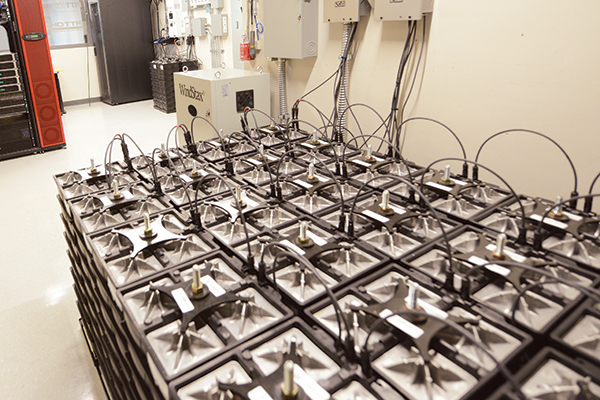
Pitt Ohio has made significant investments in clean energy, constructing LEED-certified buildings and installing renewable energy sources at multiple sites. (Pitt Ohio)
Fleets said they’re also using more natural light. Pitt Ohio has installed clerestory windows, which are placed high up in a building to help illuminate the entire room.
Burges said Dachser has switched its skylights to polycarbonate material from fiberglass because polycarbonate lets in about 40% more light.
“Over a period of time, the fiberglass will darken and deteriorate,” he said. “If you take that down 10 years’ time, that polycarbonate light will be letting in 80% more light than the fiberglass one due to the deterioration.”
Improving Heating and Cooling
Heating and cooling is another substantial source of energy demand.
Truckload carrier Schneider uses Low-E, or low-emissivity, glass in its office and shops, said Steve Parent, vice president of corporate facilities. Low-E reflects heat to its source, so it helps buildings stay cooler in the summer and warmer in the winter. Schneider also added window shades in the office to reduce heat gain.

How can fleet managers harness technology to get a better handle on vehicle speed and improve their safety culture? Host Seth Clevenger speaks with Mathieu Boivin of E-Smart and Jonathan Hubbard of SpeedGauge. Hear a snippet, above, and get the full program by going to RoadSigns.TTNews.com.
Other steps taken by Schneider include installing low-velocity, high-flow ceiling fans in the shop, adding large wall-mounted exhaust for heat dissipation in all warehouses, installing HVAC controllers to maximize efficiency and utilizing metal-clad insulated sandwich panels on the exterior of the buildings to improve insulation.
Schneider, based in Green Bay, Wis., ranks No. 5 on the for-hire TT100 and No. 18 on the TT Logistics 50.
Veritable Vegetable’s warehouses are equipped with high-efficiency refrigeration equipment and refrigeration management technology to control its storage rooms and docks.
“High-speed roll-up doors ensure food stays fresh while reducing energy usage,” Mason said.
Todd Imming, chief marketing officer for The Korte Co., a green design and construction firm based in St. Louis, said facilities can improve efficiency as well as worker comfort through the use of indoor docks. Energy loss and consumption is most affected by open areas that let heat in and out, so indoor docks help save energy and costs during winter months.
Minimizing the amount of water used at a location is another way to go green.
“We only use low-flow water fixtures, water bottle fill stations, waterless urinals, and have drought-resistant vegetation without the need for irrigation,” Pitt Ohio’s Maug said.
Dachser has an automated truck wash with a full biological reclaim unit on site.
“Because of the level of dirt on the vehicles, we use a huge amount of water in each wash. Over a five-year period, we’ll save about 26 million liters of water,” Burges said, adding that the amount saved equates to about 450,000 euros, or $487,000.
Reducing Waste
Packaging is another opportunity for freight operations to reduce waste.
Veritable Vegetable has transitioned away from one-use plastic to wrap pallets and now uses reusable pallet wraps made of breathable material.
“One 6-foot reusable pallet wrap removes 750 pounds of plastic stretch film waste going to American landfills annually,” Mason said, adding that the wraps also reduce greenhouse gas emissions, are easy to apply and remove, and save about three minutes of wrapping and unwrapping per pallet. They also are 10 times stronger than stretch film and provide more protection for plastic and cardboard boxes, she said.
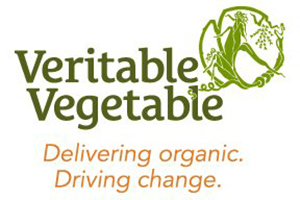
Veritable Vegetable provides reusable pallets for select customers.
“Our reusable pallets are made of recycled plastic and are 100 times more durable than a wooden pallet,” Mason said. “When we can, we source from farmers and producers who provide reusable crates rather than cardboard boxes and reusable glass bottles.”
Through its efforts, Veritable Vegetable diverts 99% of its waste from landfills.
“That means we recycle, reuse and compost nearly all the materials entering our warehouse,” Mason said, adding that the company encourages sorting of waste by all operational staff by building custom barrel holders on wheels. “This makes it easy to sort waste into larger containers for municipal pickup.”
Mason said the company has gotten creative and works with local artists and other bulk material businesses to reuse odd items such as large Styrofoam pieces or coolers and donates papers that have been used on one side to local schools. It also recycles Styrofoam at a plant to be melted down for reuse and leases a plastic bailer to bail any plastic pallet wrap and vinyl pallet ties for reuse.
Maug said achieving the high levels of efficiency Pitt Ohio has attained has been a long process that has taken years of learning, education, hard work and focus.
“Many people have worked diligently, reviewing proposals and contracts, completing construction projects, maintenance work, maintaining data logs and audits in order to have accurate measurable results,” he said.
Veritable Vegetable’s Mason said that as an early adopter, there is no road map to these environmental initiatives.
“We are heavily involved in our community and consult boards and work groups, but sometimes, we still have to be the leaders in taking the first step,” she said.
Want more news? Listen to today's daily briefing:
Subscribe: Apple Podcasts | Spotify | Amazon Alexa | Google Assistant | More

